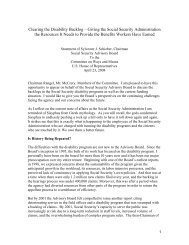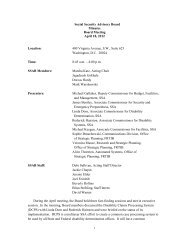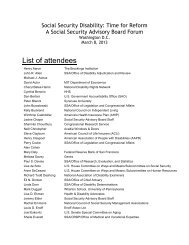Aspects of Disability Decision Making: Data and Materials
Aspects of Disability Decision Making: Data and Materials
Aspects of Disability Decision Making: Data and Materials
You also want an ePaper? Increase the reach of your titles
YUMPU automatically turns print PDFs into web optimized ePapers that Google loves.
DI: <strong>Disability</strong> Insurance under Title II <strong>of</strong> the SocialSecurity Act.DI Worker: An individual entitled to <strong>Disability</strong>Insurance benefits based on his or her own earningsaccount.<strong>Disability</strong>: For purposes <strong>of</strong> Title II (OASDI) benefits<strong>and</strong> <strong>of</strong> Title XVI (SSI) benefits for adults,disability is the inability to engage in any substantialgainful activity by reason <strong>of</strong> any medicallydeterminable impairment which can be expectedto result in death or can be expected to last for acontinuous period <strong>of</strong> not less than 12 months. Aperson must not only be unable to do his or herprevious work but cannot, considering age, education,<strong>and</strong> work experience, engage in any otherkind <strong>of</strong> substantial gainful work that exists in thenational economy. It is immaterial whether suchwork exists in the immediate area, or whether aspecific job vacancy exists, or whether the workerwould be hired if he or she applied for work. ForSSI disabled child benefits, a child under age 18 isconsidered disabled if he or she has any medicallydeterminable physical or mental impairment(s)which result(s) in marked <strong>and</strong> severe functionallimitations, <strong>and</strong> which can be expected to last for acontinuous period <strong>of</strong> not less than 12 months.<strong>Disability</strong> Determination Services (DDS): TheState agency which makes the initial <strong>and</strong> reconsiderationdetermination <strong>of</strong> whether a claimant isdisabled or a beneficiary continues to be disabledwithin the meaning <strong>of</strong> the law.<strong>Disability</strong> examiner: An employee <strong>of</strong> a State<strong>Disability</strong> Determination Services who collects<strong>and</strong> analyzes medical evidence <strong>and</strong>, in conjunctionwith a medical pr<strong>of</strong>essional, makes the determinationon a claimant’s disability.Duration: To be eligible for benefits, a claimantmust have a disabling impairment that has lastedor is expected to last for a continuous period <strong>of</strong> atleast 12 months or to result in death. (See sequentialevaluation process.)eDib: SSA’s electronic disability case processingsystem that allows the agency to process claims ina fully electronic environment. Paper copies <strong>of</strong> anyevidence or documents are converted to <strong>and</strong> storedin an electronic format.Equals the Listing: A step in the sequential evaluationprocess. An impairment may be found to be“medically equivalent” to an impairment(s) foundin the Listing <strong>of</strong> Impairments if the relevantmedical signs, symptoms, <strong>and</strong> laboratory findingsare equal in severity to those <strong>of</strong> a listed impairment.(See sequential evaluation <strong>and</strong> Listing <strong>of</strong>Impairments.)Examiner: See <strong>Disability</strong> Examiner.Hearing: The level following reconsideration inthe administrative review process. The hearing is ade novo procedure at which the claimant <strong>and</strong>/or therepresentative may appear in person, submit newevidence, examine the evidence used in makingthe determination under review, give testimony,<strong>and</strong> present <strong>and</strong> question witnesses. The hearing ison the record but is informal <strong>and</strong> non-adversarial.Hearing <strong>of</strong>fice: SSA’s Office <strong>of</strong> <strong>Disability</strong> Adjudication<strong>and</strong> Review has 161 hearing <strong>of</strong>fices (includingseven satellite <strong>of</strong>fices)around the country wherehearings are held.Incidence: The number <strong>of</strong> persons awarded benefitsin a specified period <strong>of</strong> time, per 1,000 <strong>of</strong> aspecified population. For DI benefits, the incidencerate is the number <strong>of</strong> awards in a given year per1,000 persons insured for disability benefits.Listing <strong>of</strong> Impairments: The Listing <strong>of</strong> Impairmentscontains specific medical findings that eitherestablish a diagnosis or confirm the existence <strong>of</strong> animpairment. The Listing <strong>of</strong> Impairments is dividedinto two parts – Part A describes, for each majorbody system, impairments that are consideredsevere enough to prevent an adult from doing anygainful activity. Part B contains additional criteriathat apply only to the evaluation <strong>of</strong> impairments<strong>of</strong> individuals under the age <strong>of</strong> 18. An impairmentthat meets or equals the criteria in the Listings issufficient to establish that an individual who is notworking is disabled within the meaning <strong>of</strong> the law.(See sequential evaluation.)Medical expert: A physician or mental health pr<strong>of</strong>essionalwho provides impartial expert opinionat the hearing level <strong>of</strong> the SSA disability claimsprocess.Medical Improvement Review St<strong>and</strong>ard: Theevaluation criteria used to determine whethera beneficiary continues to be disabled. Medicalimprovement will be found when there is a decrease<strong>Aspects</strong> <strong>of</strong> <strong>Disability</strong> <strong>Decision</strong> <strong>Making</strong>: <strong>Data</strong> <strong>and</strong> <strong>Materials</strong> 121









